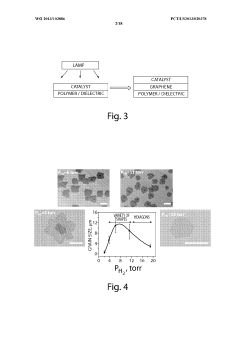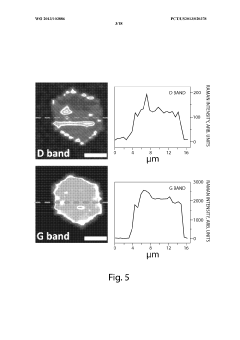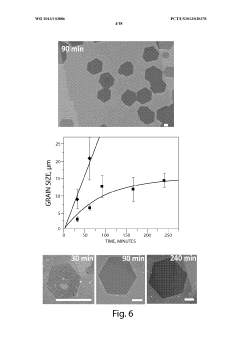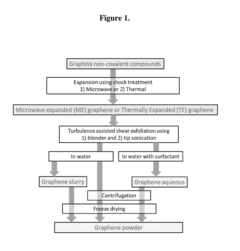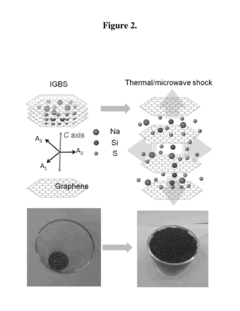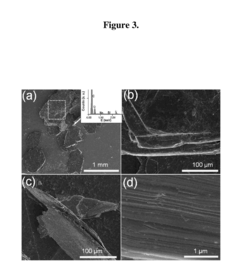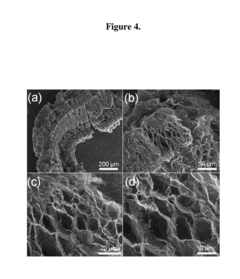The Future Of Graphene Production: Scaling Up For Commercial Use
MAY 13, 20259 MIN READ
Generate Your Research Report Instantly with AI Agent
Patsnap Eureka helps you evaluate technical feasibility & market potential.
Graphene Evolution and Objectives
Graphene, a single layer of carbon atoms arranged in a hexagonal lattice, has captivated the scientific and industrial communities since its isolation in 2004. This revolutionary material, often hailed as a "wonder material," has undergone significant development over the past two decades. The evolution of graphene production techniques has been marked by continuous efforts to improve quality, yield, and scalability. Initially, graphene was produced through mechanical exfoliation, a method that, while groundbreaking, was not suitable for large-scale production. Subsequent years saw the emergence of various production methods, including chemical vapor deposition (CVD), liquid-phase exfoliation, and epitaxial growth on silicon carbide.
The trajectory of graphene production has been driven by the material's exceptional properties, including its strength, electrical and thermal conductivity, and flexibility. These characteristics have sparked interest across diverse industries, from electronics and energy storage to aerospace and biomedical applications. As research progressed, the focus shifted from laboratory-scale production to developing methods that could meet industrial demands. This transition has been challenging, as maintaining graphene's unique properties while scaling up production has proven to be a complex task.
The primary objective in the future of graphene production is to achieve commercial viability through large-scale manufacturing processes that are both cost-effective and environmentally sustainable. This goal encompasses several key aspects: firstly, increasing production volume while maintaining consistent quality and purity of graphene sheets. Secondly, reducing production costs to make graphene competitive with existing materials in various applications. Thirdly, developing standardized production methods that can be easily adopted by industries across different sectors.
Another critical objective is to bridge the gap between laboratory discoveries and real-world applications. This involves not only scaling up production but also tailoring graphene's properties to meet specific industry requirements. For instance, the electronics industry may require defect-free, large-area graphene sheets, while energy storage applications might benefit from graphene with controlled porosity or functionalization.
Environmental considerations also play a crucial role in shaping the future of graphene production. As the world moves towards more sustainable technologies, there is a growing emphasis on developing eco-friendly production methods that minimize the use of harsh chemicals and reduce energy consumption. This aligns with the broader goal of making graphene a key player in green technologies, from more efficient solar cells to advanced water purification systems.
The trajectory of graphene production has been driven by the material's exceptional properties, including its strength, electrical and thermal conductivity, and flexibility. These characteristics have sparked interest across diverse industries, from electronics and energy storage to aerospace and biomedical applications. As research progressed, the focus shifted from laboratory-scale production to developing methods that could meet industrial demands. This transition has been challenging, as maintaining graphene's unique properties while scaling up production has proven to be a complex task.
The primary objective in the future of graphene production is to achieve commercial viability through large-scale manufacturing processes that are both cost-effective and environmentally sustainable. This goal encompasses several key aspects: firstly, increasing production volume while maintaining consistent quality and purity of graphene sheets. Secondly, reducing production costs to make graphene competitive with existing materials in various applications. Thirdly, developing standardized production methods that can be easily adopted by industries across different sectors.
Another critical objective is to bridge the gap between laboratory discoveries and real-world applications. This involves not only scaling up production but also tailoring graphene's properties to meet specific industry requirements. For instance, the electronics industry may require defect-free, large-area graphene sheets, while energy storage applications might benefit from graphene with controlled porosity or functionalization.
Environmental considerations also play a crucial role in shaping the future of graphene production. As the world moves towards more sustainable technologies, there is a growing emphasis on developing eco-friendly production methods that minimize the use of harsh chemicals and reduce energy consumption. This aligns with the broader goal of making graphene a key player in green technologies, from more efficient solar cells to advanced water purification systems.
Commercial Demand Analysis
Graphene, often hailed as a wonder material, has been the subject of intense research and development since its discovery in 2004. As we analyze the commercial demand for graphene, it's clear that the material's unique properties have sparked interest across various industries. The global graphene market is projected to grow significantly, with estimates suggesting a compound annual growth rate (CAGR) of over 30% in the coming years. This growth is driven by the material's potential applications in electronics, energy storage, composites, and biomedical fields.
The electronics industry, in particular, shows strong demand for graphene due to its exceptional electrical conductivity and flexibility. Manufacturers are exploring graphene's use in transparent conductive films for touchscreens, flexible displays, and high-performance transistors. The energy sector is another key driver of graphene demand, with research focused on improving battery and supercapacitor performance. Graphene's high surface area and conductivity make it an attractive material for enhancing energy storage devices, potentially revolutionizing electric vehicle technology and grid-scale energy storage solutions.
In the composites industry, graphene's strength-to-weight ratio and barrier properties are generating significant interest. Aerospace, automotive, and construction sectors are investigating graphene-enhanced materials for lighter, stronger, and more durable products. The biomedical field is also exploring graphene's potential in drug delivery systems, biosensors, and tissue engineering, although regulatory hurdles may slow commercial adoption in this sector.
Despite the promising outlook, challenges remain in scaling up graphene production to meet commercial demands. Current production methods are often costly and limited in scale, which has kept graphene prices relatively high and restricted its widespread adoption. However, as production techniques improve and economies of scale are achieved, the price of graphene is expected to decrease, potentially opening up new markets and applications.
The regional distribution of graphene demand shows strong growth in Asia-Pacific, particularly in China and South Korea, where government support and industrial policies are driving research and commercialization efforts. North America and Europe also demonstrate significant market potential, with established research institutions and innovative startups pushing the boundaries of graphene applications.
As the graphene market matures, we anticipate a shift from research-driven demand to more commercial applications. This transition will likely be accompanied by increased standardization efforts and quality control measures to ensure consistent product performance across different applications. The development of graphene-based products that offer clear advantages over existing materials will be crucial in driving widespread commercial adoption and realizing the full market potential of this revolutionary material.
The electronics industry, in particular, shows strong demand for graphene due to its exceptional electrical conductivity and flexibility. Manufacturers are exploring graphene's use in transparent conductive films for touchscreens, flexible displays, and high-performance transistors. The energy sector is another key driver of graphene demand, with research focused on improving battery and supercapacitor performance. Graphene's high surface area and conductivity make it an attractive material for enhancing energy storage devices, potentially revolutionizing electric vehicle technology and grid-scale energy storage solutions.
In the composites industry, graphene's strength-to-weight ratio and barrier properties are generating significant interest. Aerospace, automotive, and construction sectors are investigating graphene-enhanced materials for lighter, stronger, and more durable products. The biomedical field is also exploring graphene's potential in drug delivery systems, biosensors, and tissue engineering, although regulatory hurdles may slow commercial adoption in this sector.
Despite the promising outlook, challenges remain in scaling up graphene production to meet commercial demands. Current production methods are often costly and limited in scale, which has kept graphene prices relatively high and restricted its widespread adoption. However, as production techniques improve and economies of scale are achieved, the price of graphene is expected to decrease, potentially opening up new markets and applications.
The regional distribution of graphene demand shows strong growth in Asia-Pacific, particularly in China and South Korea, where government support and industrial policies are driving research and commercialization efforts. North America and Europe also demonstrate significant market potential, with established research institutions and innovative startups pushing the boundaries of graphene applications.
As the graphene market matures, we anticipate a shift from research-driven demand to more commercial applications. This transition will likely be accompanied by increased standardization efforts and quality control measures to ensure consistent product performance across different applications. The development of graphene-based products that offer clear advantages over existing materials will be crucial in driving widespread commercial adoption and realizing the full market potential of this revolutionary material.
Graphene Production Challenges
Graphene production has faced significant challenges in scaling up for commercial use, primarily due to the complexity of maintaining its unique properties during mass production. The current state of graphene production is characterized by a dichotomy between high-quality, small-scale production methods and large-scale, but lower-quality processes. Laboratory-scale production techniques, such as mechanical exfoliation and chemical vapor deposition (CVD), yield high-quality graphene but are not suitable for industrial-scale manufacturing. On the other hand, liquid-phase exfoliation and reduction of graphene oxide can produce larger quantities but often result in graphene with more defects and lower performance.
One of the main technical hurdles is the lack of standardization in graphene production and characterization. This has led to inconsistencies in product quality and performance across different manufacturers, making it challenging for end-users to integrate graphene into their applications reliably. Additionally, the high cost of production remains a significant barrier to widespread adoption, with current prices making graphene economically unfeasible for many potential applications.
Environmental and safety concerns also pose challenges to large-scale graphene production. The use of harsh chemicals in some production methods raises questions about environmental impact and worker safety, necessitating the development of greener and safer production processes. Furthermore, the potential health effects of graphene nanoparticles are not yet fully understood, which has led to regulatory uncertainties and hesitation in some industries.
The geographical distribution of graphene production capabilities is currently concentrated in a few regions, with China, the United States, and Europe leading in research and production capacity. This concentration presents challenges in terms of supply chain resilience and global access to graphene materials. Efforts to establish production facilities in other regions are ongoing but face obstacles in terms of technology transfer and infrastructure development.
Despite these challenges, recent advancements in production techniques show promise for overcoming some of these hurdles. Innovations in CVD processes, such as roll-to-roll production, are improving the scalability of high-quality graphene production. Similarly, advancements in liquid-phase exfoliation techniques are enhancing the quality of graphene produced at larger scales. Researchers are also exploring novel approaches, such as electrochemical exfoliation and plasma-enhanced CVD, which may offer new pathways to scalable, high-quality graphene production.
One of the main technical hurdles is the lack of standardization in graphene production and characterization. This has led to inconsistencies in product quality and performance across different manufacturers, making it challenging for end-users to integrate graphene into their applications reliably. Additionally, the high cost of production remains a significant barrier to widespread adoption, with current prices making graphene economically unfeasible for many potential applications.
Environmental and safety concerns also pose challenges to large-scale graphene production. The use of harsh chemicals in some production methods raises questions about environmental impact and worker safety, necessitating the development of greener and safer production processes. Furthermore, the potential health effects of graphene nanoparticles are not yet fully understood, which has led to regulatory uncertainties and hesitation in some industries.
The geographical distribution of graphene production capabilities is currently concentrated in a few regions, with China, the United States, and Europe leading in research and production capacity. This concentration presents challenges in terms of supply chain resilience and global access to graphene materials. Efforts to establish production facilities in other regions are ongoing but face obstacles in terms of technology transfer and infrastructure development.
Despite these challenges, recent advancements in production techniques show promise for overcoming some of these hurdles. Innovations in CVD processes, such as roll-to-roll production, are improving the scalability of high-quality graphene production. Similarly, advancements in liquid-phase exfoliation techniques are enhancing the quality of graphene produced at larger scales. Researchers are also exploring novel approaches, such as electrochemical exfoliation and plasma-enhanced CVD, which may offer new pathways to scalable, high-quality graphene production.
Current Graphene Scaling Methods
01 Large-scale production methods
Various techniques for scaling up graphene production have been developed, including chemical vapor deposition (CVD), liquid-phase exfoliation, and electrochemical exfoliation. These methods aim to increase yield and efficiency while maintaining graphene quality. Continuous production processes and automated systems are being implemented to achieve industrial-scale manufacturing.- Large-scale production methods: Various methods have been developed for large-scale production of graphene, including chemical vapor deposition (CVD), liquid-phase exfoliation, and electrochemical exfoliation. These techniques aim to produce high-quality graphene in large quantities, suitable for industrial applications. Continuous production processes and automated systems have been implemented to increase throughput and efficiency.
- Graphene quality control and characterization: Ensuring consistent quality in large-scale graphene production is crucial. Advanced characterization techniques and quality control measures have been developed to monitor and maintain the structural integrity, purity, and properties of graphene during mass production. These include spectroscopic methods, microscopy techniques, and automated inspection systems.
- Functionalization and modification for specific applications: To enhance graphene's properties for specific applications, various functionalization and modification techniques have been scaled up. These processes involve chemical treatments, doping, or composite formation to tailor graphene's characteristics for use in electronics, energy storage, or advanced materials. Large-scale functionalization methods have been developed to maintain graphene's unique properties while improving its compatibility with different matrices.
- Environmental and cost-effective production: Efforts have been made to develop environmentally friendly and cost-effective methods for large-scale graphene production. These include using renewable precursors, implementing green chemistry principles, and optimizing energy consumption in production processes. Recycling and waste reduction strategies have also been incorporated to make graphene production more sustainable at industrial scales.
- Integration with existing manufacturing processes: To facilitate the adoption of graphene in various industries, methods have been developed to integrate graphene production and incorporation into existing manufacturing processes. This includes in-situ graphene growth on substrates, direct incorporation into composite materials, and development of graphene-based intermediate products that can be easily used in conventional manufacturing lines.
02 Graphene synthesis from carbon-rich precursors
Methods for producing graphene from carbon-rich materials such as coal, biomass, or waste plastics have been developed. These approaches offer cost-effective and sustainable alternatives for large-scale graphene production. The processes often involve thermal or chemical treatments to convert the precursor materials into high-quality graphene sheets.Expand Specific Solutions03 Functionalization and modification techniques
Various methods for functionalizing and modifying graphene have been developed to enhance its properties and expand its applications. These techniques include chemical doping, surface modification, and the creation of graphene composites. Such modifications can improve graphene's electrical, mechanical, and chemical properties, making it suitable for a wider range of industrial applications.Expand Specific Solutions04 Quality control and characterization methods
Advanced techniques for quality control and characterization of graphene produced at scale have been developed. These include spectroscopic methods, microscopy techniques, and electrical measurements to assess the structural integrity, purity, and properties of graphene. Automated and high-throughput characterization systems are being implemented to ensure consistent quality in large-scale production.Expand Specific Solutions05 Application-specific production processes
Tailored production processes have been developed for specific graphene applications, such as energy storage, electronics, and composites. These processes focus on optimizing graphene properties for particular end-uses, including controlling layer thickness, defect density, and surface chemistry. Such application-specific production methods aim to meet the unique requirements of different industries and enhance the commercial viability of graphene-based products.Expand Specific Solutions
Key Graphene Industry Players
The graphene production industry is in a transitional phase, moving from research-driven development to commercial scaling. The market size is expanding rapidly, with projections indicating significant growth potential. Technologically, graphene production is advancing, but challenges in large-scale, cost-effective manufacturing persist. Companies like Global Graphene Group, Paragraf Ltd., and Black Swan Graphene are at the forefront of commercialization efforts. Academic institutions such as the University of Alabama and Shanghai Jiao Tong University continue to drive fundamental research. Collaborations between industry players like Samsung Electronics and research institutions are accelerating progress towards viable mass production techniques, indicating a maturing but not yet fully mature technology landscape.
Global Graphene Group, Inc.
Technical Solution: Global Graphene Group has developed a proprietary manufacturing process called "Honeycomb Production" for large-scale graphene production. This method utilizes a continuous roll-to-roll process that allows for the creation of high-quality graphene sheets with controlled thickness and properties. The process involves the exfoliation of graphite into graphene layers using a combination of chemical and mechanical treatments. The resulting graphene is then deposited onto a substrate in a honeycomb-like structure, which enhances its strength and conductivity. This scalable approach enables the production of graphene at industrial quantities while maintaining consistent quality.
Strengths: Scalable production, consistent quality, and customizable properties. Weaknesses: High initial investment costs and potential environmental concerns related to chemical treatments.
Paragraf Ltd.
Technical Solution: Paragraf has pioneered a unique approach to graphene production using a modified Chemical Vapor Deposition (CVD) process. Their technology, called "Direct Deposition," allows for the growth of high-quality, large-area graphene directly onto semiconductor wafers without the need for transfer steps. This process involves the precise control of gas flow, temperature, and pressure in a specially designed reactor. The resulting graphene is uniform, contamination-free, and can be directly integrated into electronic devices. Paragraf's method significantly reduces the complexity and cost associated with traditional graphene production and integration techniques, making it particularly suitable for commercial applications in electronics and sensors.
Strengths: Direct integration with semiconductors, high purity, and scalability. Weaknesses: Limited to certain substrate materials and potentially higher production costs compared to some other methods.
Breakthrough Graphene Patents
High quality large scale single and multilayer graphene production by chemical vapor deposition
PatentWO2013103886A1
Innovation
- The method involves passing a catalyst substrate through a heated chemical vapor deposition chamber at atmospheric pressure, exposing it to a reaction gas mixture of methane and hydrogen, with hydrogen acting as a co-catalyst to control graphene grain shape and dimension, and using alternative heating methods like infrared lamps or inductive heating to achieve controlled growth of continuous graphene layers.
Expansion and exfoliation of graphite to form graphene
PatentInactiveUS20180370801A1
Innovation
- A two-step expansion-exfoliation method using commercially available expandable graphite, where microwave or thermal shock treatment creates large flakes with minimal oxygen content, followed by shear exfoliation to produce high-quality few-layer graphene with controlled interlayer spacing and crystallinity, avoiding chemical reactions and maintaining structural integrity.
Graphene Supply Chain Analysis
The graphene supply chain is a complex network of stakeholders involved in the production, distribution, and application of this revolutionary material. As graphene production scales up for commercial use, understanding and optimizing this supply chain becomes crucial for industry success. The supply chain begins with raw material suppliers, primarily providing graphite or other carbon-based sources. These materials then undergo various production processes, such as chemical vapor deposition (CVD) or exfoliation, to create graphene. Key players in this stage include specialized graphene manufacturers and research institutions developing novel production techniques.
Following production, graphene undergoes quality control and characterization to ensure it meets the required specifications for different applications. This step involves advanced analytical equipment and expertise, often provided by specialized testing facilities or in-house capabilities of larger manufacturers. The next stage in the supply chain involves intermediaries who process raw graphene into more application-ready forms, such as graphene oxide, graphene nanoplatelets, or graphene-enhanced composites. These intermediaries play a crucial role in bridging the gap between raw material producers and end-users.
Distribution networks then come into play, connecting graphene producers and processors with various industries and end-users. These networks may include specialized materials distributors, industry-specific suppliers, and direct business-to-business relationships. As graphene finds applications across diverse sectors such as electronics, energy storage, composites, and biomedical devices, the supply chain expands to encompass a wide range of industries and end-users.
A critical aspect of the graphene supply chain is the development of standards and regulations. Organizations like the International Organization for Standardization (ISO) and the Graphene Flagship are working to establish consistent quality and safety standards, which are essential for large-scale commercialization. Additionally, intellectual property considerations play a significant role in shaping the supply chain, with patents and licensing agreements influencing production methods and applications.
As graphene production scales up, the supply chain faces several challenges and opportunities. These include optimizing production costs, ensuring consistent quality across large volumes, developing sustainable and environmentally friendly production methods, and creating efficient recycling and waste management processes. Addressing these challenges will be crucial for the long-term viability and growth of the graphene industry, ultimately enabling its widespread commercial adoption across various sectors.
Following production, graphene undergoes quality control and characterization to ensure it meets the required specifications for different applications. This step involves advanced analytical equipment and expertise, often provided by specialized testing facilities or in-house capabilities of larger manufacturers. The next stage in the supply chain involves intermediaries who process raw graphene into more application-ready forms, such as graphene oxide, graphene nanoplatelets, or graphene-enhanced composites. These intermediaries play a crucial role in bridging the gap between raw material producers and end-users.
Distribution networks then come into play, connecting graphene producers and processors with various industries and end-users. These networks may include specialized materials distributors, industry-specific suppliers, and direct business-to-business relationships. As graphene finds applications across diverse sectors such as electronics, energy storage, composites, and biomedical devices, the supply chain expands to encompass a wide range of industries and end-users.
A critical aspect of the graphene supply chain is the development of standards and regulations. Organizations like the International Organization for Standardization (ISO) and the Graphene Flagship are working to establish consistent quality and safety standards, which are essential for large-scale commercialization. Additionally, intellectual property considerations play a significant role in shaping the supply chain, with patents and licensing agreements influencing production methods and applications.
As graphene production scales up, the supply chain faces several challenges and opportunities. These include optimizing production costs, ensuring consistent quality across large volumes, developing sustainable and environmentally friendly production methods, and creating efficient recycling and waste management processes. Addressing these challenges will be crucial for the long-term viability and growth of the graphene industry, ultimately enabling its widespread commercial adoption across various sectors.
Environmental Impact Assessment
As graphene production scales up for commercial use, it is crucial to assess its environmental impact. The manufacturing process of graphene involves various methods, including chemical vapor deposition, exfoliation, and reduction of graphene oxide, each with its own environmental implications. One of the primary concerns is the energy consumption associated with large-scale production. High-temperature processes and the use of specialized equipment can lead to significant carbon emissions if not managed properly. Additionally, the use of chemicals in certain production methods may result in hazardous waste that requires careful handling and disposal.
However, the environmental impact of graphene production must be balanced against its potential benefits. Graphene's unique properties could lead to more efficient and environmentally friendly technologies in various sectors. For instance, graphene-enhanced batteries could improve energy storage capabilities, potentially accelerating the adoption of renewable energy sources. In water treatment, graphene-based membranes show promise for more effective desalination and purification processes, addressing global water scarcity issues.
The production of graphene also raises concerns about resource consumption, particularly the use of rare or precious metals as catalysts in some manufacturing processes. Sustainable sourcing of raw materials and the development of recycling methods for graphene-based products will be essential to mitigate long-term environmental impacts. Furthermore, the potential release of graphene nanoparticles into the environment during production or from graphene-containing products is an area that requires careful study and monitoring to ensure ecosystem and human health safety.
As the industry scales up, implementing green chemistry principles and circular economy approaches will be crucial. This includes developing more environmentally friendly production methods, such as using renewable energy sources, minimizing waste generation, and exploring bio-based precursors for graphene synthesis. Life cycle assessments of graphene production and its applications will be necessary to fully understand and optimize its environmental footprint.
Regulatory bodies and industry stakeholders must work together to establish guidelines and standards for sustainable graphene production. This may involve setting limits on emissions, waste generation, and energy consumption, as well as promoting best practices for environmental management in graphene manufacturing facilities. By addressing these environmental considerations proactively, the graphene industry can ensure that the scaling up of production for commercial use aligns with global sustainability goals and contributes positively to addressing environmental challenges.
However, the environmental impact of graphene production must be balanced against its potential benefits. Graphene's unique properties could lead to more efficient and environmentally friendly technologies in various sectors. For instance, graphene-enhanced batteries could improve energy storage capabilities, potentially accelerating the adoption of renewable energy sources. In water treatment, graphene-based membranes show promise for more effective desalination and purification processes, addressing global water scarcity issues.
The production of graphene also raises concerns about resource consumption, particularly the use of rare or precious metals as catalysts in some manufacturing processes. Sustainable sourcing of raw materials and the development of recycling methods for graphene-based products will be essential to mitigate long-term environmental impacts. Furthermore, the potential release of graphene nanoparticles into the environment during production or from graphene-containing products is an area that requires careful study and monitoring to ensure ecosystem and human health safety.
As the industry scales up, implementing green chemistry principles and circular economy approaches will be crucial. This includes developing more environmentally friendly production methods, such as using renewable energy sources, minimizing waste generation, and exploring bio-based precursors for graphene synthesis. Life cycle assessments of graphene production and its applications will be necessary to fully understand and optimize its environmental footprint.
Regulatory bodies and industry stakeholders must work together to establish guidelines and standards for sustainable graphene production. This may involve setting limits on emissions, waste generation, and energy consumption, as well as promoting best practices for environmental management in graphene manufacturing facilities. By addressing these environmental considerations proactively, the graphene industry can ensure that the scaling up of production for commercial use aligns with global sustainability goals and contributes positively to addressing environmental challenges.
Unlock deeper insights with Patsnap Eureka Quick Research — get a full tech report to explore trends and direct your research. Try now!
Generate Your Research Report Instantly with AI Agent
Supercharge your innovation with Patsnap Eureka AI Agent Platform!

